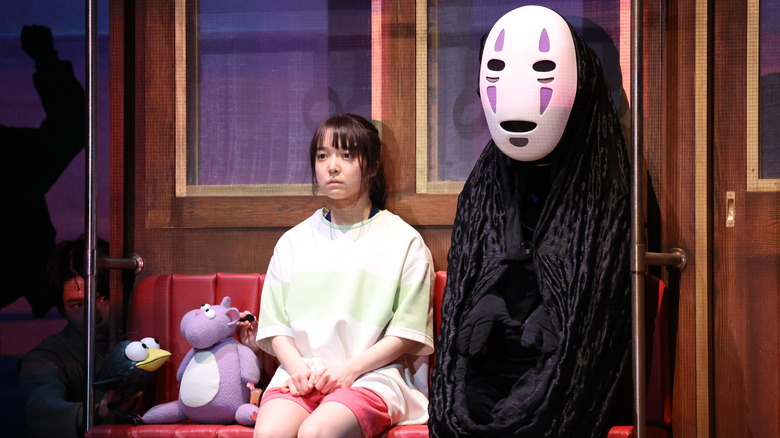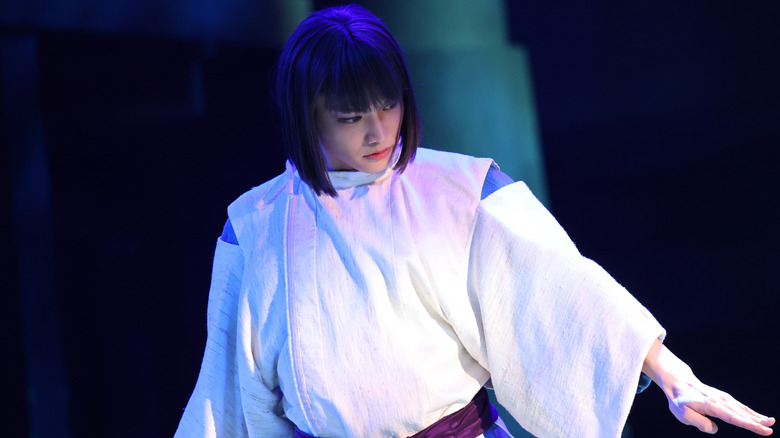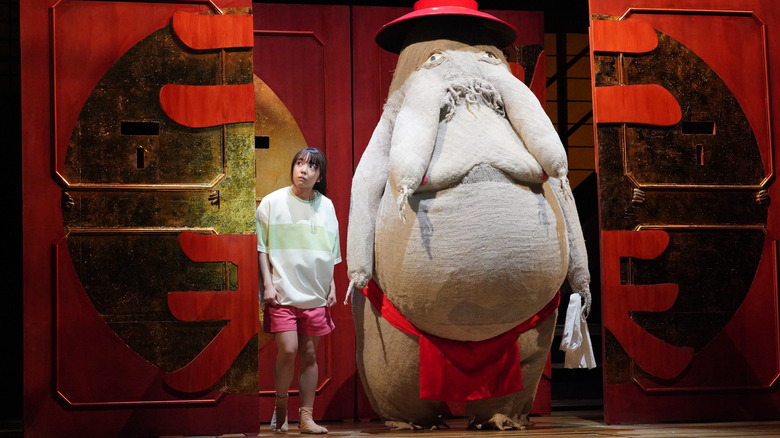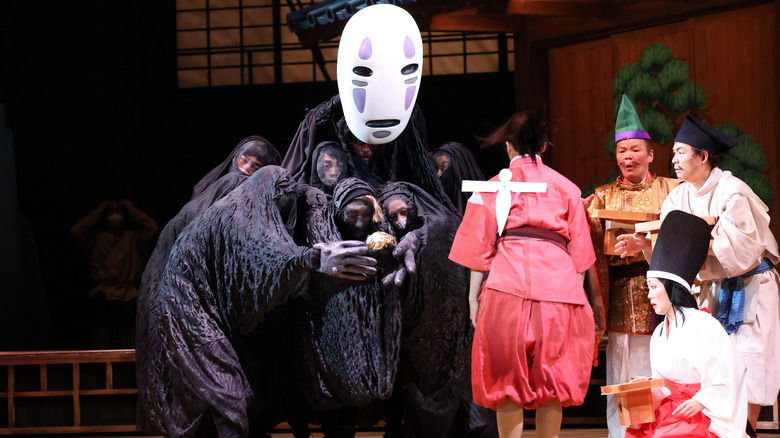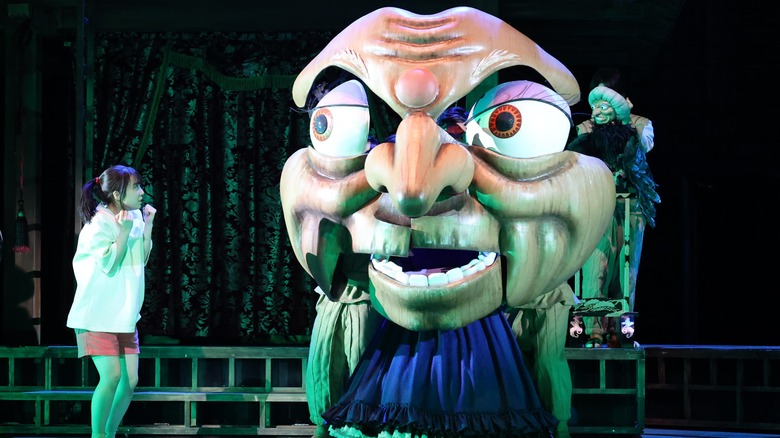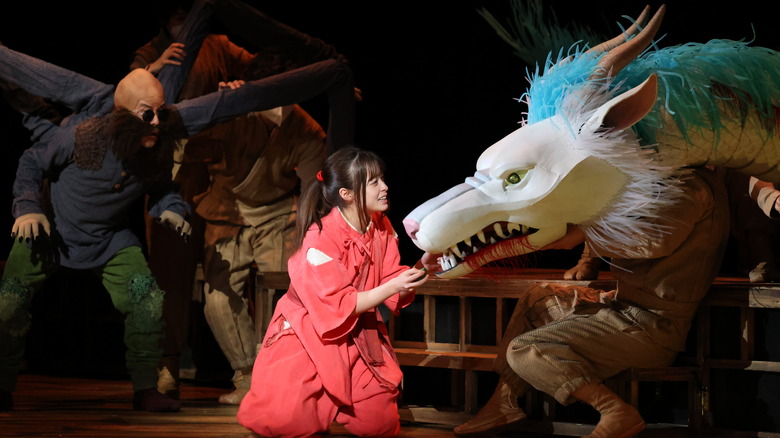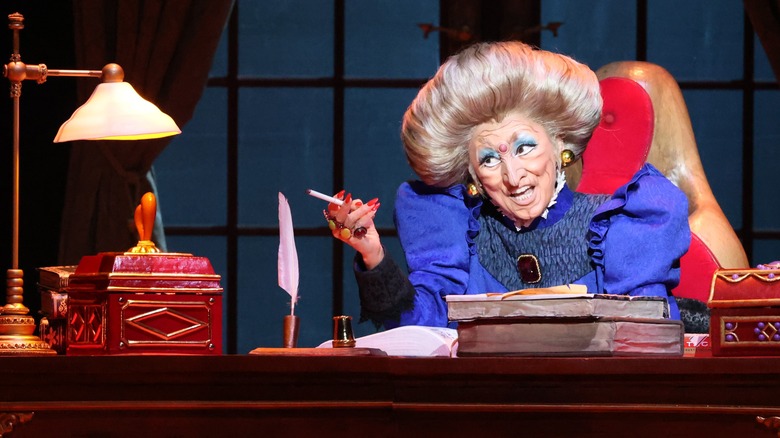Spirited Away: Live On Stage Director John Caird On Achieving The Impossible [Exclusive Interview]
With "Spirited Away: Live on Stage," Tony Award-winning theater director John Caird took on the risky yet rewarding creative challenge of adapting one of the most beloved animated films ever made. To date, Hayao Miyazaki and Studio Ghibli's original animated version of "Spirited Away" remains the only non-English language film to win an Oscar for Best Animated Feature. Just last year, it made Sight and Sound's once-a-decade list of the greatest movies of all time.
Fortunately, "Spirited Away: Live on Stage" had an asset in Caird, who originated the long-running "Les Misérables" stage adaptation in London and now serves as honorary associate director of the Royal Shakespeare Company. When "Spirited Away: Live on Stage" premiered last March in Japan, it was able to immediately sidestep any concerns about doing Miyazaki's film justice with the release of several eye-catching images, showing what Caird and collaborators like puppetry designer Toby Olié had accomplished.
Starting April 23, animation distributor GKIDS and Ghibli Fest 2023 will make it possible for stateside moviegoers to finally see two different filmed performances of "Spirited Away: Live on Stage," starring Kanna Hashimoto and Mone Kamishiraishi in the double-cast lead role of Chihiro. The performances were shot during the production's initial run at Tokyo's historic Imperial Theatre in 2022.
Ahead of the North American theatrical release of "Spirited Away: Live on Stage," I had the pleasure of speaking with Caird about his impressions of Miyazaki upon meeting him, collaborating with Olié and other designers via Zoom, the challenge of bringing transformative characters like No-Face to life on stage, and directing Mari Natsuki, the original actress who voiced the bathhouse witch Yubaba and inspired her character design in animation.
Note: This interview has been lightly edited for clarity and brevity.
'We're really presenting ... an authentic piece of Japanese culture to a Western audience'
"Spirited Away" obviously started out as a Japanese animated movie, which you're now bringing to a North American audience as a filmed stage version. What were the challenges of translating it across different mediums and cultures like that?
Well, the biggest challenge was obviously finding a physical production for the show that would stand up to scrutiny. We haven't really brought it across cultures because it's all in Japanese and we're using surtitles, and so we're really presenting, as it were, an authentic piece of Japanese culture to a Western audience on this occasion.
In the press notes, it mentioned that you and Hayao Miyazaki clicked right away and he signed off on this adaptation immediately because he felt "Spirited Away" belonged to the world now. Was he involved beyond the initial stages, or did he just give you his blessing and let you do your own thing?
Not at all. He wasn't involved at all, and he said from the very beginning, because I asked him, "Do you want to be?" Because I'd be very happy to accommodate him, obviously, but he said, "No, no." He's got his own new movie to do and he can't think of anything else while he's doing that.
He's almost like a hermit now, I think. He doesn't even like going into what he calls Tokyo, even though he lives in Tokyo. He means he doesn't like going into the middle of the city, because he's enshrined in his own little world of creating his next movie, which of course he should be. We're all relying on that. That's what we revere in him is his ability to concentrate on the next work and not sit around admiring himself for the previous ones.
'I had to surround myself with brilliant collaborators'
One of the things that got people so excited about this stage production last year was seeing images from it, like Chihiro and the Radish Spirit on the elevator. For you as a theater director, did the inherent visual quality of Miyazaki's work sort of lend itself naturally to a dynamic stage presentation?
Yes, exactly. You put it very well. And I knew from the outset that if I was to make a success of it, I had to surround myself with brilliant collaborators. In the case you mentioned, the puppet master Toby Olié, who'd created "War Horse" and a string of other wonderful shows, he was absolutely instrumental in designing the vivid puppet versions of Miyazaki's animated characters.
There are some moments in this where the line between sets and costumes and puppetry almost gets a little blurred. I'm thinking of things like the human hydrangeas, or Kamaji's six arms, or the transformations that Yubaba and No-Face undergo. How closely were your set designer and costume designer and Toby all working together? I mean, what was that process like?
Yeah, all the time we were working together. It was constrained because my designers were all unable to visit Japan because of Covid. They weren't allowed into Japan, so they were doing everything on Zoom. But we worked together as a team, collaboratively. I mean, things like the hydrangeas. Originally in the design, we just had a sort of clumpy bit of hydrangea that we moved on as a piece of set. I thought, "We're working in a fluid — why can't a person be a bush?" So we just stuck some flowers on somebody, and it is just so much more fun to work like that.
And it's one of the tenets of what I do, really, as a director, is I love to — theater magic isn't like film magic. You're not creating the impossible. You are creating something that's beautiful and you are showing the audience how you're doing it. But it's still magic, even though they can see how it's done. It's a sort of conspiracy, if you like, between the performer and the audience to agree that something has reality on stage.
'And the next impossible thing we have to do today...'
Were there any abandoned concepts for this production that could have taken it in a different direction? Something you couldn't make work, or something that just maybe fell by the wayside?
No. Every morning of rehearsal, I opened my remarks to the cast by saying, "And the next impossible thing we have to do today is we have to create a man with six arms," or "we have to create a Kaonashi [No-Face] with 10 dancers," or whatever it was. "We have to create an elevator that goes to four different floors that opens and closes." It was always a sense of what great fun it was, what a great privilege it was to be doing the impossible every day.
I imagine that No-Face in particular might have been challenging, trying to bring him to life.
Very challenging, yeah. But we were very blessed there because we had these two absolutely staggeringly brilliant dancers, Tomo [Tomohiko Tsujimoto] and Koha [Koharu Sugawara], both of them are absolutely brilliant in creating a character who could just float across the stage without seemingly being human at all.
'Miyazaki had based the drawings of Yubaba's face on Mari's face'
You mentioned your various collaborators. Having directed Mari Natsuki in "Les Misérables," what was it like reuniting with her for "Spirited Away" and seeing her reprise her voice role of Yubaba and Zenibaba in live-action? Were there any special insights she provided as a cast member from the original?
Yeah, she was really wonderful, and it was great. She was the sort of grandmother of the whole project, because she brought such authenticity to the language, having, as you say, done the voice in the original movie. And she's a wonderful actress. She's got great integrity and great fun. She also told me that Miyazaki had based the drawings of Yubaba's face on Mari's face.
Oh, really?
Because he knew Mari years before.
I don't know if that's very flattering. [laughs]
No, but she's very proud of the fact that she provided the visual information for Miyazaki to make the image of a witch. I don't know how true that was. I wasn't present at that conversation, but Mari's sure it's the case. But of course, it was fantastic to have Mari in rehearsal. She's a great spirit.
'I approached Ghibli'
What was your personal entry point for "Spirited Away"? I mean, how did the idea for this whole stage adaptation originally come about? Did you approach Ghibli or did someone approach you?
Yeah, I approached Ghibli. I've always loved the film, and I was searching for projects that could fill the huge Imperial Theatre in Tokyo, a 2,000-seat theater. And it just suddenly occurred to me, "Why don't we have a go? Why don't see if Ghibli will agree to us doing 'Spirited Away?'" Because it's such a massive, beautiful, epic show. And because it's all in one location, if you can find a way of putting the bathhouse on stage in a way that's really interesting and dynamic, you should be able to tell the story. That was my opening gambit with Hayao Miyazaki and [Ghibili co-founder] Toshio Suzuki. That's what I went to sell them when I went to see them.
What was it about Chihiro's story that appealed to you from a narrative perspective?
Well, it's just wonderfully complex, sort of coming-of-age story about a little girl who's a whiny, dissatisfied sort of...
Brat? I don't know if that's the right word for it.
A half-pint little brat who is negative about everything. She just grows and grows in stature until she becomes — very important, this — she becomes a moral force. It's partly about her physical courage and her physical ability and the fact that she gets braver and braver, but she becomes more and more moral. She does what she does because it's right to do it. And she's inspired by love — love of her parents, love of Haku. But in the end, everything she does is inspired by wanting to make things better for everybody. It's a wonderful story to tell, a story about the positive influence we can have on other people's lives.
'It's about the spirit of the thing'
I know in theater, sometimes there are practical considerations that lead to double casting. But with "Spirited Away," you have this precedent for dual names and twin witches. And now in the stage version, you've also got this new twist with the actors who play Chihiro's parents doing double duty as characters in the spirit world. How did the double casting and the increased duality become part of your approach?
Well, it's never good to have actors sitting in the dressing room for half the evening. Actors love to be involved. Thematic doubling has been with us ever since Shakespeare. If you've got the ghost in Hamlet, you don't want him just doing the ghost and then disappearing. So he could also be the grave digger, or he can be Claudius or whatever.
In this case, I thought Chihiro's father, there is actually a character in the show called Chichiyaku, which is the father guy. But he's a very small role. So that would be an obvious double. You could have done that. In the end, I did it with Aniyaku, the dancing servant in the bathhouse. But it also struck me, you could do a double of Chihiro's father and Kamaji, but that's a bit harder because the father needs to be a father figure, and Kamaji is a sort of grandfather figure. So if you found the right actor, you could do that.
Then the mother could become Yubaba, But the actor is too old for that. But Lin seemed the right thing because Lin takes on a sort of maternal role towards Chihiro. So it's about the spirit of the thing. Who would you want the mother to become? Well, Lin seems the obvious answer.
You have these films now, which are making it possible for people to see the full performances from Toho's 90th anniversary celebration last year. But is there a chance sometime in the future that people might be able to see "Spirited Away" revived on stage in a city near them?
I would love that to happen. That would be one of my dearest wishes. So let's see.
"Spirited Away: Live on Stage" is in theaters on April 23 and 27 as part of Ghibli Fest 2023.
